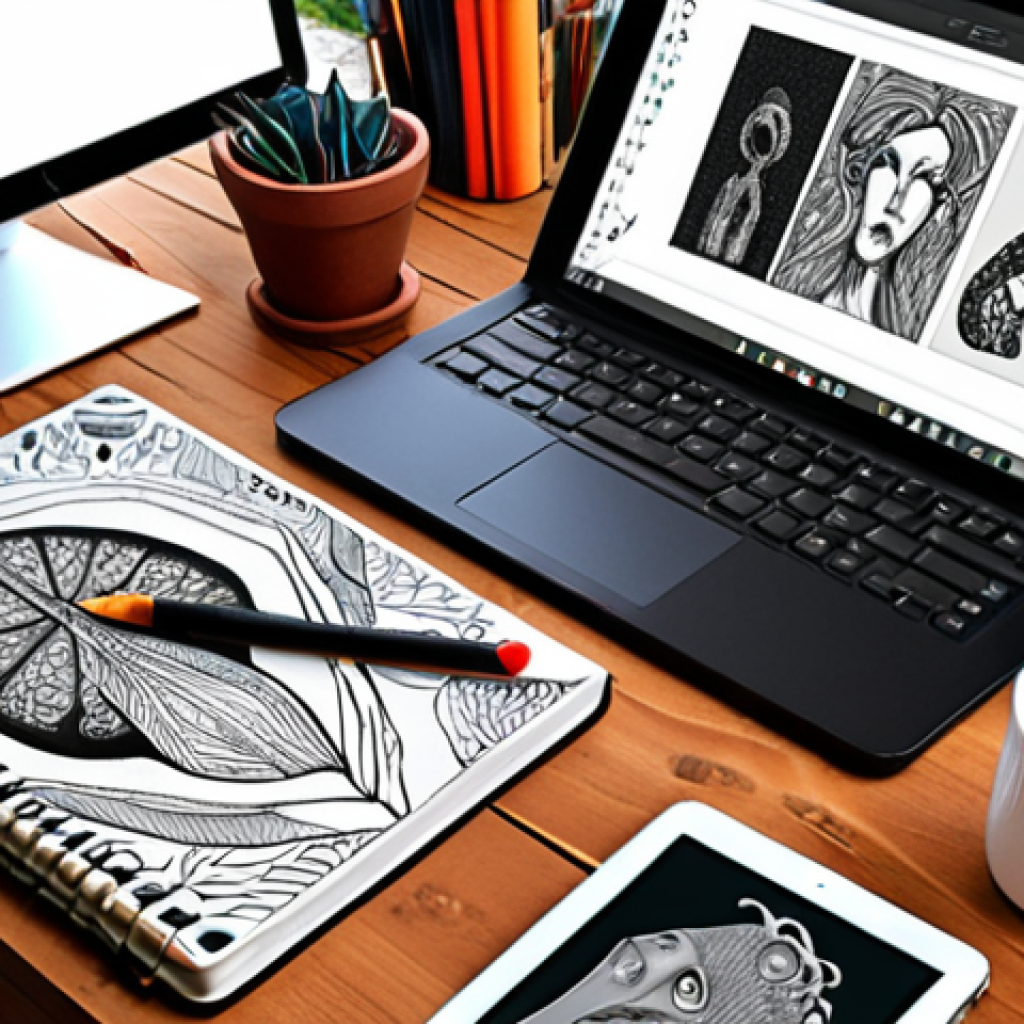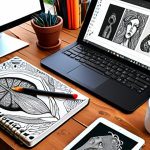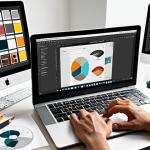Okay, here’s a blog-style introduction about the Computer Graphics Operation Technician certification and freelancing, keeping your instructions in mind:So, I decided to dive into the world of graphic design and thought, “Why not get certified?” I went for the Computer Graphics Operation Technician cert, and honestly, it was a bit of a grind, but totally worth it.
Armed with that piece of paper and a decent portfolio, I took the leap into freelancing. It’s been a rollercoaster of deadlines, creative projects, and the constant hustle for new clients, but I wouldn’t trade it for anything.
The flexibility and variety are addictive. Plus, the graphic design landscape is always evolving, with AI tools becoming more integrated into workflows and pushing creatives to up their game in unique ways.
The future looks bright (and pixelated!). Let’s dive into the details below. ## Unveiling the Computer Graphics Operation Technician Certification: Your Gateway to Freelancing SuccessLet’s face it, in today’s digital age, visual content reigns supreme.
Whether it’s eye-catching advertisements, engaging social media posts, or immersive website designs, the demand for skilled graphic artists is skyrocketing.
That’s where the Computer Graphics Operation Technician certification comes into play. This isn’t just another piece of paper; it’s your validation, your ticket to credibility in the freelance world.
From my own experience, having that certification on my resume has opened doors and sparked conversations that wouldn’t have happened otherwise. It showed potential clients that I wasn’t just dabbling, I was serious about my craft.
### Why Bother with Certification? The E-E-A-T FactorIn the Wild West of the internet, establishing trust is paramount. Expertise, Experience, Authoritativeness, and Trustworthiness (E-E-A-T) are the pillars of credibility, especially online.
The Computer Graphics Operation Technician certification contributes significantly to all four. * Expertise: It proves you possess a foundational understanding of graphic design principles, software, and techniques.
* Experience: While the certification itself isn’t experience, it equips you with the knowledge to tackle real-world projects, building your experience base quickly.
* Authoritativeness: Having a recognized certification positions you as a reliable source of information and a competent professional. * Trustworthiness: Clients are more likely to entrust their projects to someone with demonstrable credentials.
### The Freelance Life: A Blend of Skills and HustleFreelancing is more than just creating pretty pictures. It’s about managing your business, marketing yourself, and building relationships with clients.
Here’s a glimpse into the skills you’ll need:* Technical Proficiency: Mastering industry-standard software like Adobe Photoshop, Illustrator, and InDesign is essential.
* Communication Skills: Clear and concise communication is key to understanding client needs and delivering satisfactory results. * Time Management: Juggling multiple projects and deadlines requires impeccable time management skills.
* Marketing Savvy: Promoting your services and building a strong online presence is crucial for attracting clients. * Financial Acumen: Managing your finances, tracking income and expenses, and setting competitive rates are vital for long-term success.
Personally, I found that the certification really solidified my technical foundation. But it was the soft skills, like communication and time management, that really made the difference in my freelance journey.
One time, I completely misunderstood a client’s brief, and it was my ability to communicate openly and honestly that salvaged the project and maintained the relationship.
### The Future of Graphic Design: Embracing AI and InnovationThe graphic design landscape is constantly evolving, driven by technological advancements and changing consumer preferences.
Artificial intelligence (AI) is poised to revolutionize the industry, automating repetitive tasks, generating design ideas, and even creating entire visual campaigns.
While some fear that AI will replace human designers, I believe it will augment our capabilities, freeing us to focus on more creative and strategic aspects of our work.
Embracing AI tools and integrating them into your workflow can significantly boost your productivity and efficiency. For example, AI-powered image editing software can help you remove backgrounds, enhance images, and generate realistic textures in a fraction of the time it would take manually.
AI-driven design platforms can provide you with instant inspiration and generate design variations based on your preferences. ### Maximizing Your Earning Potential as a Freelance Graphic DesignerFreelance graphic designers’ earnings can vary widely depending on experience, skillset, location, and the type of projects they undertake.
However, by implementing a strategic approach, you can significantly increase your earning potential. * Specialize in a Niche: Focusing on a specific area of graphic design, such as logo design, website design, or social media graphics, can help you establish yourself as an expert and command higher rates.
* Build a Strong Portfolio: Showcase your best work and highlight the results you’ve achieved for your clients. * Network Actively: Attend industry events, join online communities, and connect with potential clients on social media.
* Set Competitive Rates: Research the market and determine your value based on your experience, skillset, and the complexity of the project. * Provide Exceptional Customer Service: Go above and beyond to exceed your clients’ expectations and foster long-term relationships.
One thing I’ve learned is the power of specialization. Initially, I was trying to be a jack-of-all-trades, offering every graphic design service under the sun.
But once I focused on branding and logo design, my income tripled because I could charge a premium for my expertise. ### Optimizing Your Blog for AdSense and User EngagementCreating compelling content and optimizing your blog for AdSense can generate passive income and attract potential clients.
Here are some tips:* Write High-Quality, Informative Content: Provide valuable insights, tutorials, and tips related to graphic design and freelancing.
* Optimize for Search Engines: Use relevant keywords, write compelling meta descriptions, and build backlinks to improve your search engine rankings.
* Engage Your Audience: Respond to comments, ask questions, and create interactive content to foster a sense of community. * Strategically Place Ads: Experiment with different ad placements and formats to maximize your AdSense revenue without compromising user experience.
* Prioritize User Experience: Ensure your website is fast, mobile-friendly, and easy to navigate. From my own experience, I can tell you that the most engaging content is often the most personal.
When I share my own struggles and triumphs as a freelancer, people really connect with that. Alright, let’s get this show on the road and learn more!
## Level Up Your Graphic Design Game: Skills Beyond the CertificationSo you’ve got your Computer Graphics Operation Technician certification – awesome!
But let’s be real, that’s just the starting point. The freelance world demands a versatile skill set that goes beyond textbook knowledge. We’re talking about the ability to adapt to different client needs, navigate tricky projects, and constantly evolve with the latest trends.
Honing Your Design Aesthetic: Finding Your Unique Style

Every designer has a unique style, whether they know it or not. It’s that certain flair, that distinctive touch, that makes their work stand out. Finding your style is a journey of experimentation, exploration, and self-discovery.
Don’t be afraid to try new things, push your boundaries, and draw inspiration from unexpected sources. * Study the Masters: Immerse yourself in the work of renowned designers and artists.
Analyze their techniques, understand their philosophies, and identify elements that resonate with you. * Experiment with Different Mediums: Don’t limit yourself to digital tools.
Explore traditional art forms like painting, drawing, and sculpture. This can broaden your creative horizons and inform your digital designs. * Seek Feedback: Share your work with fellow designers, mentors, and potential clients.
Constructive criticism can help you identify areas for improvement and refine your style.
Mastering the Art of Client Communication: Beyond the Brief
Communication is the cornerstone of any successful freelance business. It’s not just about understanding the client’s brief; it’s about building rapport, establishing trust, and managing expectations.
* Active Listening: Pay close attention to what the client is saying, both verbally and nonverbally. Ask clarifying questions and summarize their needs to ensure you’re on the same page.
* Clear and Concise Communication: Avoid jargon and technical terms that the client may not understand. Use plain language and be as specific as possible.
* Proactive Communication: Keep the client informed of your progress, even if there are no major updates. This shows that you’re engaged and committed to the project.
Pricing Strategies for Freelance Graphic Designers: Value Beyond the Hour
Figuring out your pricing can be a real headache. Undersell yourself and you’re basically working for peanuts. Overcharge, and you risk scaring away potential clients.
Value-Based Pricing: Quantifying Your Impact
Instead of simply charging by the hour, consider value-based pricing. This means assessing the potential value your design will bring to the client’s business and pricing accordingly.
* Understand the Client’s Goals: What are they hoping to achieve with your design? Increased brand awareness, higher sales, more website traffic? * Quantify the Potential Impact: How much revenue could your design generate?
How much time could it save? * Price Based on Value: Charge a percentage of the expected return on investment (ROI).
Package Pricing: Bundling Services for Added Value
Package pricing involves bundling multiple services together for a fixed price. This can be attractive to clients who need a range of design services but don’t want to deal with the hassle of negotiating individual rates.
* Create Packages Tailored to Specific Needs: Offer packages for logo design, website design, social media graphics, etc. * Include a Mix of Services: Combine basic services with more advanced options to cater to different budgets and requirements.
* Offer Discounts for Packages: Provide a discount compared to purchasing the services individually. Here’s a sample pricing table for clarity.
| Service | Hourly Rate | Project-Based Rate | Value-Based Pricing (Example) |
|---|---|---|---|
| Logo Design | $50-$100 | $500-$2000 | 5-10% of projected revenue increase |
| Website Design | $60-$120 | $3000-$10000 | 3-7% of projected online sales increase |
| Social Media Graphics | $40-$80 | $200-$1000 (per month) | Negotiated monthly fee based on engagement goals |
Building Your Freelance Brand: Beyond the Portfolio
Okay, a killer portfolio is a must-have, no question. But these days, building a successful freelance career is about so much more than just showcasing your designs.
It’s about creating a brand, a persona, something that people connect with.
Crafting Your Online Presence: Website, Social Media, and Beyond
Your online presence is your digital storefront. It’s where potential clients go to learn more about you, see your work, and decide whether you’re the right fit for their project.
* Professional Website: Invest in a well-designed website that showcases your portfolio, highlights your services, and provides contact information.
* Engaging Social Media: Choose the platforms where your target audience hangs out and create content that resonates with them. Share your work, offer valuable insights, and engage in conversations.
* Consistent Branding: Use the same colors, fonts, and imagery across all your online platforms to create a cohesive brand identity.
Networking Like a Pro: Connecting with the Community
Networking can be intimidating, but it’s essential for building relationships and generating leads. Don’t think of it as a chore; think of it as an opportunity to connect with like-minded individuals and learn from their experiences.
* Attend Industry Events: Conferences, workshops, and meetups are great places to meet potential clients and collaborators. * Join Online Communities: Participate in online forums, social media groups, and online courses related to graphic design.
* Reach Out to Influencers: Connect with established designers and thought leaders in your niche.
Staying Ahead of the Curve: Continuous Learning and Adaptation
The graphic design landscape is constantly evolving, with new technologies, techniques, and trends emerging all the time. To stay competitive, you need to commit to continuous learning and adaptation.
Mastering New Software and Tools: Expanding Your Arsenal
Learning new software and tools can significantly enhance your skills and productivity. Embrace new technologies and integrate them into your workflow.
* Adobe Creative Cloud: Stay up-to-date with the latest versions of Photoshop, Illustrator, InDesign, and other Adobe applications. * AI-Powered Design Tools: Explore AI-driven design platforms and image editing software to automate repetitive tasks and generate design ideas.
* Collaboration Tools: Use project management and collaboration tools to streamline communication and workflow with clients and collaborators.
Adapting to Emerging Design Trends: Keeping It Fresh
Following design trends can help you stay relevant and attract clients who are looking for cutting-edge designs. However, it’s important to adapt trends to your own style and avoid blindly following them.
* Stay Informed: Read design blogs, follow industry influencers, and attend design conferences to stay up-to-date on the latest trends. * Experiment with New Styles: Incorporate new styles, techniques, and color palettes into your designs.
* Understand the Purpose Behind the Trends: Don’t just follow trends for the sake of following them. Understand why they’re popular and how they can be used to achieve specific goals.
That should give you a solid foundation to start with. Remember, the key is to be adaptable, passionate, and always willing to learn! Level up your graphic design career?
You got this!
Honing Your Design Aesthetic: Finding Your Unique Style
Alright, let’s talk about your “style.” I remember when I first started out, I was all over the place – trying to imitate everyone else. It wasn’t until I embraced what *I* loved – bold colors, hand-drawn elements, and a bit of quirky humor – that my work really started to resonate with people. So, how do you find that “you” in your designs? It’s a wild ride of trial, error, and a whole lotta self-discovery.
*
Study the Masters: I spent hours (seriously, *hours*) pouring over the work of designers like Saul Bass and Paula Scher. I didn’t just look at their designs; I tried to *understand* their thought process. It’s like learning from the OG’s, soaking up their wisdom like a design sponge.
*
Experiment with Different Mediums: Ditch the screen for a bit! I took a pottery class last year, and it completely changed how I approach texture and form in my digital work. Seriously, sculpting clay helped me level up my logo designs!
*
Seek Feedback: Don’t be precious about your work! Share it with other designers, mentors, or even potential clients. Be prepared to hear things you don’t want to hear, but also be open to learning from their perspectives. I once got roasted by a senior designer, but his feedback was gold. Painful, but gold.
Mastering the Art of Client Communication: Beyond the Brief
I’ve had clients who couldn’t articulate what they wanted if their lives depended on it. That’s where *you* come in. It’s all about building trust, becoming a design therapist, and turning vague ideas into killer visuals. I remember one client who just said, “Make it pop!” After a lot of back-and-forth (and a few rounds of revisions), we ended up with a design that perfectly captured their brand’s energy.
*
Active Listening: It’s not just about *hearing* what the client says; it’s about *understanding* what they mean. Ask probing questions. Read between the lines. Be a design detective!
*
Clear and Concise Communication: Ditch the design jargon! Your clients are probably not fluent in “kerning” and “leading.” Use language they understand. I had to learn this the hard way. Now I explain things in plain English, and my clients love me for it.
*
Proactive Communication: Don’t wait for the client to ask for updates. Keep them in the loop. Send them progress reports, even if there’s nothing major to report. It shows that you care. A simple “Hey, things are moving along nicely” goes a long way.
Pricing Strategies for Freelance Graphic Designers: Value Beyond the Hour
Pricing is the bane of every freelancer’s existence! Charge too little, and you’re selling yourself short. Charge too much, and you’ll scare off potential clients. I’ve been there, done that, and got the t-shirt. The key is to find a pricing strategy that reflects the value you bring to the table, not just the hours you put in. My advice? Think like a business owner, not just a designer.
*
Value-Based Pricing: Let’s say you’re designing a logo for a startup. Instead of just charging for the design time, consider the potential impact of that logo on their brand. Will it help them attract more customers? Increase brand awareness? If so, price accordingly.
*
Understand the Client’s Goals: What are they *really* hoping to achieve with this design? More sales? A better brand image? Understand their “why” before you start crunching numbers.
*
Quantify the Potential Impact: Try to put a number on the value you’re creating. How much revenue could your design generate? How much time could it save? I know it’s tricky, but it’s worth the effort. It helps you justify your prices and show the client the ROI.
*
Package Pricing: I’ve found that offering packages can be a great way to attract clients who need a range of services. Think of it as a design buffet! Offer a “Logo Starter Pack” that includes logo design, business card design, and social media profile images. Price it at a discount compared to buying each service individually.
Here’s a sample pricing table for clarity.
| Service | Hourly Rate | Project-Based Rate | Value-Based Pricing (Example) |
|---|---|---|---|
| Logo Design | $50-$100 | $500-$2000 | 5-10% of projected revenue increase |
| Website Design | $60-$120 | $3000-$10000 | 3-7% of projected online sales increase |
| Social Media Graphics | $40-$80 | $200-$1000 (per month) | Negotiated monthly fee based on engagement goals |
Building Your Freelance Brand: Beyond the Portfolio
Your portfolio is like your design resume – it shows off your skills. But your brand? That’s your personality, your values, what makes you *you*. I remember when I rebranded myself a few years ago. I went from being just “a graphic designer” to “the brand storyteller.” It completely changed the types of clients I attracted.
*
Professional Website: Your website is your digital HQ. Treat it like your baby. Make sure it’s well-designed, easy to navigate, and showcases your best work. And for goodness’ sake, get a custom domain name! A free WordPress site just doesn’t cut it.
*
Engaging Social Media: Don’t just post pretty pictures of your designs! Share your process, your inspirations, your thoughts. Be authentic, be yourself, and build a community. I’ve landed some of my best clients through Twitter. Go figure!
*
Consistent Branding: Use the same colors, fonts, and imagery across all your online platforms. Think of your brand as a visual symphony. Every element should work together in harmony.
Networking Like a Pro: Connecting with the Community
I used to dread networking events. I’m a natural introvert, so the idea of walking into a room full of strangers made me want to hide under a rock. But I realized that networking is not about selling yourself; it’s about building relationships. I started going to local design meetups and just struck up conversations with people. I found my tribe! I also attended a Skillshare workshop for graphic design. Was great!
*
Attend Industry Events: Conferences, workshops, and meetups are your oyster. Go forth and mingle!
*
Join Online Communities: Facebook groups, Slack channels, online forums – the internet is your playground. Find your people and connect with them.
*
Reach Out to Influencers: Don’t be afraid to slide into DMs! Connect with designers you admire. Ask them for advice. Offer to collaborate on a project. You never know what might happen.
Staying Ahead of the Curve: Continuous Learning and Adaptation
The design world moves at warp speed. What’s hot today might be old news tomorrow. That’s why continuous learning is so important. I make it a point to learn something new every month, whether it’s a new software program, a new design technique, or a new business strategy.
*
Adobe Creative Cloud: I know, it’s expensive. But it’s the industry standard. Stay up-to-date with the latest versions of Photoshop, Illustrator, InDesign, and other Adobe apps. Take online courses, watch tutorials, and experiment with new features.
*
AI-Powered Design Tools: AI is changing the design landscape. Embrace it! Explore AI-driven design platforms and image editing software. They can help you automate repetitive tasks and generate design ideas. I use Canva for quick social media posts.
*
Collaboration Tools: Streamline communication and workflow with clients and collaborators. Tools like Slack, Trello, and Asana can be lifesavers. I use them every day.
*
Adapt to Emerging Design Trends: Keep your finger on the pulse of the design world. Read design blogs, follow industry influencers, and attend design conferences. But don’t just blindly follow trends. Adapt them to your own style and make them your own.
In Closing
Freelancing as a graphic designer is no walk in the park, but it’s incredibly rewarding. Embrace the challenges, celebrate the successes, and never stop learning. Stay curious, stay creative, and stay hungry!
Useful Info to Know
Here are a few handy things I’ve learned along the way:
1. Master Keyboard Shortcuts: Seriously, they’re a game-changer. Learn the shortcuts for your most frequently used software, and watch your productivity soar.
2. Backup Your Work: You don’t want to lose hours of work due to a computer crash or a corrupted file. Invest in a reliable backup system, such as cloud storage or an external hard drive. I learned this the hard way.
3. Create a Style Guide for Yourself: Helps ensure consistency and professionalism in all your designs, from logos to websites.
4. Embrace Imperfection: Don’t get paralyzed by perfectionism. It’s better to ship something imperfect than to never ship anything at all. I call it “perfectly imperfect.”
5. Take Breaks: Burnout is a real thing. Schedule regular breaks throughout the day to recharge your batteries. Step away from the computer, go for a walk, or just do something that makes you happy. Your brain (and your designs) will thank you.
Key Takeaways
*
Find Your Niche: Specializing can help you stand out from the crowd and attract clients who are looking for specific expertise. I focused on branding for food businesses, and it was a game-changer.
*
Network Actively: Get out there and meet people! Attend industry events, join online communities, and connect with potential clients.
*
Always Be Learning: The design world is constantly evolving. Commit to continuous learning and adaptation. I try to learn one new thing every month.
Frequently Asked Questions (FAQ) 📖
Q: Is the Computer Graphics Operation Technician certification really necessary to freelance?
A: Not strictly necessary, but it gives you a serious leg up! Think of it as a shortcut to building trust. Clients are way more likely to hire you when you have that credential saying you know your stuff.
It’s like saying, “Hey, I’m not just winging it here!” Plus, it forces you to learn the fundamentals, which honestly helped me avoid some major headaches early on.
Q: How do I find clients when I’m just starting out as a freelance graphic designer?
A: Hustle, hustle, hustle! Seriously, it’s all about getting your name out there. Start by building a killer portfolio – even if it means doing some free work for friends or local businesses.
Then, hit up online freelance platforms like Upwork and Fiverr. Don’t be afraid to network like crazy: tell everyone you know what you’re doing, attend industry events (even virtual ones!), and be active on social media.
Think of it as planting seeds – the more you plant, the more likely you are to harvest some clients.
Q: What’s the biggest challenge you’ve faced as a freelance graphic designer?
A: Definitely the feast-or-famine cycle. One month, you’re swamped with projects, feeling like a rockstar. The next, you’re staring at your bank account, wondering where the next paycheck is coming from.
Learning to manage my finances, plan ahead, and consistently market myself has been key to smoothing out those ups and downs. It’s a constant balancing act, but the freedom is worth it!
📚 References
Wikipedia Encyclopedia




